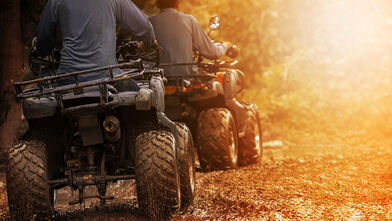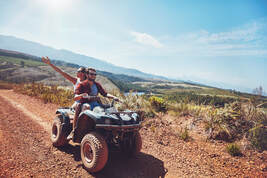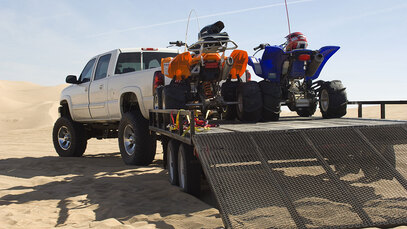Harris, Reed & Seiferth
|
 There have been times in my life when I've felt severely unprepared. I remember starting drivers training and getting behind the wheel for the first time with my instructor, nervously thinking to myself, We've only talked about driving in the classroom—I don't think I'm ready to be on the roads! And during my time as a college student, I've known the horror of being caught off guard by spontaneous pop quizzes. I've even found myself at the starting line of a 25K road running race, regretfully wishing that I had spent more than just two weeks training for the event. Recalling these experiences makes me glad I was not negligent my first time riding an ATV. This time, I felt prepared. I had carefully learned the rules of riding safely, I was wearing the proper gear, and I was on trails designated for off-road vehicles with other experienced and responsible riders. This preparation gave me confidence and allowed me to relax and enjoy the ride. It was an absolute blast! Riding an ATV can be thrilling, but also dangerous, so it's important to brush up on how to ride safely before you hit the trails. Whether you are a new rider learning for the first time or an ATV veteran in need of a quick refresher, here are ten tips for being prepared and staying safe on your off-road adventures:
Source: https://www.foremost.com/learning-center/off-road-adventures-staying-safe-on-your-atv.asp
0 Comments
 What do outdoor adventures look like for you? Whether it's an ATV, UTV, dirt bike, dune buggy, golf cart or other off-road vehicle (ORV), you'll want to make sure you have the right type of insurance coverage to protect your toys. It's important to ask your independent insurance agent the right questions about what type of coverage you're seeking and customize it to fit your lifestyle. To help you get started, we put together the following list of questions after speaking with Kevin Henry, the Director of Product Management at Foremost® Insurance. 1. What typical coverages are available for ATV/UTVs? "Ask your agent or broker about standard coverages that are available, as well as optional ones you might consider," says Henry. "Standard coverages include Collision, Other Than Collision, Liability and Medical Payments. They help provide coverage for damage to your ATV itself or damage or injury that you may cause while riding your ATV." 2. Is my safety apparel covered? "Whether it's helmets, goggles or other clothing that helps minimize injuries from an accident, most companies will offer safety apparel coverage for when these things get damaged," says Henry. "We want riders to be as safe as possible while enjoying the outdoors, so we encourage wearing safety gear." 3. Is there optional equipment coverage available? "Most people have customized or added options to their ATVs," Henry explains. "Optional Equipment coverage helps cover things like towable trailers, racks and winch kits for your ATV." 4. Am I able to insure my ATV/UTV year-round? "Year-round coverage is definitely something you may want to consider," answers Henry. "Some policies have a lay-up period for colder weather when you may not be able to ride. But when an unusually warm day comes around and you want to take your ATV out, you might be stuck without coverage. A year-round policy lets you take it out whenever Mother Nature's providing good weather and, with some companies, you can do this for the same price as seasonal coverage." 5. What kinds of discounts are available? "Everybody wants to save money," Henry shares. "Ask what's available for you. Some companies, like Foremost, offer discounts for things like multi-units, multi-policies, maintaining continuous coverage when you renew and for having prior off-road vehicle insurance." Your safety is number one to us. Stay safe wherever you choose to go on your off-road vehicle. Looking for ATV insurance? Get a quote today by calling 561-768-8176 to speak with a licensed agent. Source: https://www.foremost.com/learning-center/top-questions-to-ask-about-off-road-vehicle-insurance.asp  Some people have trails or areas where they can ride their Off-Road Vehicles at home, but others may have to take their ORVs somewhere else to ride. For instance, many people take their Golf Carts with them when camping or haul their ATVs and UTVs to designated riding trails. To get your ORV to these places, you'll probably want to tow it with a trailer. If you've never towed an ORV with a trailer before, follow these steps to keep your ORV from moving around or falling off!
https://www.foremost.com/learning-center/towing-an-orv-with-a-trailer.asp https://www.golfstorageguide.com/how-to-tow-a-golf-cart-on-a-trailer/ https://www.tires-easy.com/blog/towing-atv-trailer-tires/ |
Categories
All
Archives
May 2024
|
Social MediaContact UsNavigation |
|
Website by InsuranceSplash
Privacy Policy | Terms of Use
© 2025 by HARRIS, REED & SEIFERTH INSURANCE GROUP, INC. All rights reserved.
© 2025 by HARRIS, REED & SEIFERTH INSURANCE GROUP, INC. All rights reserved.

 RSS Feed
RSS Feed